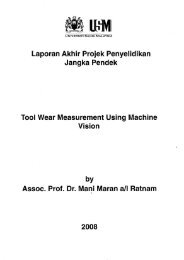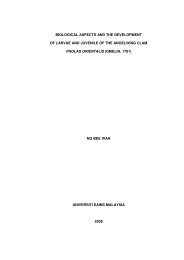design and development of a secure wireless ... - ePrints@USM
design and development of a secure wireless ... - ePrints@USM
design and development of a secure wireless ... - ePrints@USM
Create successful ePaper yourself
Turn your PDF publications into a flip-book with our unique Google optimized e-Paper software.
CHAPTER 2<br />
LITERATURE REVIEW<br />
2.1 Introduction<br />
Wireless networking is a rapidly emerging technology <strong>and</strong> security must be<br />
addressed as it is incorporated into new <strong>and</strong> existing local area networks<br />
(LANs). It is important to know what unique properties <strong>of</strong> <strong>wireless</strong> LANs might<br />
amplify existing LAN vulnerabilities or introduce new ones.<br />
Wireless local area networks (WLANs) are a new alternative to traditional hard<br />
wired local area networks (LANs). They use radio frequency (RF) or infrared (IR)<br />
transmissions to communicate information from one point to another <strong>and</strong> do not<br />
rely on physical connections. A typical WLAN configuration includes an access<br />
point (AP) connected to the wired network using st<strong>and</strong>ard cabling. An access<br />
point antenna is mounted anywhere practical to obtain desired coverage.<br />
WLANs can provide continuous network access to users within their organization<br />
thus supporting productivity not possible with wired networks. People can<br />
physically move their node (computer) without breaking their virtual network<br />
connection. This will termed “roaming”.<br />
GSM is a system currently in use, <strong>and</strong> is the second-generation (2G) <strong>of</strong> mobilecommunication<br />
networks. When it is in the st<strong>and</strong>ard mode <strong>of</strong> operation, it<br />
10

















